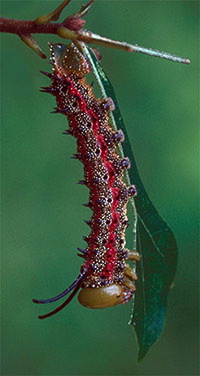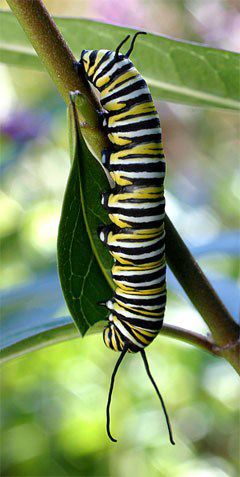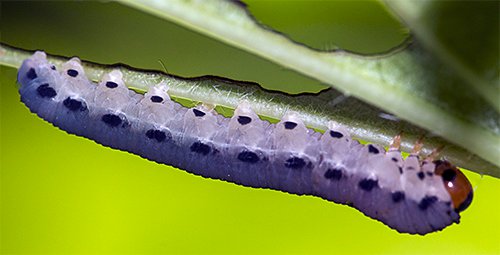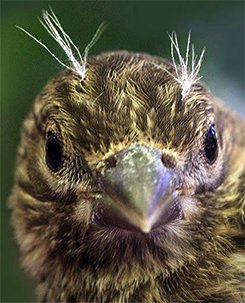|
HOME: www.hiltonpond.org |
|||
THIS WEEK at HILTON POND Subscribe for free to our award-winning nature newsletter (Back to Preceding Week; on to Next Week) |
CATERPILLAR, MAGGOT, Come midsummer, a white-flowered Viburnum brightens the view from the dining room of the old farmhouse at Hilton Pond Center. This time of year, however, the shrub bears only green leaves--growing opposite each other on every twig. One morning this week we noticed the Viburnum's foliage had been ravaged overnight, so we went out to investigate, suspecting hungry caterpillars at work. Sure enough, beneath several petioles--about all that remained of some leaves--we found little gray insect larvae with black spots, many of which were chewing away on what leaf blades remained. "Hmmm, caterpillars," was our first thought, but on closer examination we realized they actually weren't. And that realization brings us to this week's discussion about immature insects--caterpillars, maggots, larvae, and grubs--and their differences.
All text, maps, charts & photos © Hilton Pond Center Those numerous larvae (above) on our Viburnum shrub did for all the world look like caterpillars and even acted like them, crawling along leaf edges with six legs (a typical characteristic of insects whether adult or immature). Several additional pairs of "prolegs"--muscular, enervated extensions of the abdomen--helped the larvae cling to their leafy perches, and it was these prolegs that told us our caterpillar-like creatures weren't really caterpillars after all.
All text, maps, charts & photos © Hilton Pond Center By scientific definition, caterpillars are larval stages of the Lepidoptera, an insect order that includes butterflies and moths. All lepidopterans undergo complete metamorphosis, the four stages being egg, larva, pupa, and adult. Larva go through five growth stages of their own, shedding and forming skins as they get to optimal pre-pupal size. The caterpillar in the photo just above is the final instar of the Catalpa Sphinx Moth--a larva known more famously by fisherpeople 'round these parts as the "Catawba Worm." This photo clearly shows three pairs of jointed insect legs, four pairs of prolegs, and a proleg-like "clasper" at the terminus of the abdomen.
All text, maps, charts & photos © Hilton Pond Center Two similar lepidopteran larvae depicted in head-down images above are those of the Oakworm Moth (left) and the familiar Monarch butterfly (right). Again we see three pairs of true legs, four pairs of prolegs, and a terminal clasper--although the latter is poorly developed in the Monarch larvae.
All text, maps, charts & photos © Hilton Pond Center So here's the clue that told us the larvae chowing down on our Viburnum leaves would NEVER turn into scaly-winged butterflies or moths: Simply count the prolegs. Our newly found gray larvae (above) had six true legs, a clasper, and SEVEN proleg pairs--'way too many for caterpillars that have no more than four or five pairs of abdominal prolegs. Our Viburnum-eater was the larval form of an insect unrelated to lepidopterans; it was a Sawfly and a member of the Hymenoptera--the order that also includes membranous-winged wasps, bees, and ants.
All text, maps, charts & photos © Hilton Pond Center Although we're not sure of the specific I.D. of the larval sawfly we found on the Viburnum, we HAVE identified other local species--including the Butternut Woolyworm Sawfly caterpillar, Eriocampa juglandis (above). Note the seven pairs of prolegs? (If you happen to know the common and/or scientific names for our Viburnum sawfly, please send a note to INFO.)
All text, maps, charts & photos © Hilton Pond Center Adults Butternut Woolyworm Sawflies (shown mating, above, with smaller male on the left), are typical of their close kin--differentiated from many other hymenopterans by the lack of a narrowed waist between abdomen and thorax. The common name "sawfly" comes from the shape of the female's ovipositor, a serrated structure with which she cuts through a host plant's tissues prior to egg-laying. When each of these eggs hatches, it yields a larva with the six or more pairs of prolegs characteristic of sawflies.
All text, maps, charts & photos © Hilton Pond Center Thus, the larvae of butterflies and sawflies are similar in having six true walking legs but differ in the number of pairs of prolegs. There ARE other caterpillar-like larvae that also have six true legs, but these lack any prolegs at all. We refer here to "grubs," the common name for larvae of the Beetle Order (Coleoptera). The scarab beetle grub above does indeed have six well-developed walking legs found on insects, but its abdominal segments lack prolegs; there's also no clasper at the tip of the abdomen. And unlike mostly freely crawling butterfly caterpillars and sawfly larvae, beetle grubs are usually found buried in soil or in dead wood or--in the case of many scarabs--feeding and growing within a decomposing deep deposit of dung.
All text, maps, charts & photos © Hilton Pond Center Another kind of insect larvae that might be thought of as caterpillar-like are those from flies (Diptera), but these are very much different from immature butterflies, sawflies, or beetles. A fly larva (above)--which goes by the unappetizing epithet "maggot"--is little more than a wriggling, writhing digestive canal: A head and mouth, a long intestine, and an anus, with no walking legs and no prolegs whatsoever. (Although they may resemble various "worms," maggots are insects--not annelids.) Maggots move by bulldozing through dead matter, contorting themselves into moist places where they avoid the light of day. We should be very appreciative of hard-working maggots--little legless larvae without which we would be up to our eyeballs in road kills. (We might add that maggots are often accompanied in their thankless but important task by the grubs of various beetles; caterpillars seem to opt out of this environmental role.) There are lots of other immature insects (dragonfly nymphs and wingless true bugs, for example), but none are likely to be mistaken for caterpillars or--now that you know the "pro-leggy" hints for identification--to be confused with sawfly larvae . . . or maggots . . . or grubs.
All contributions are tax-deductible on your |
|---|
|
"This Week at Hilton Pond" is written and photographed by Dr. Bill Hilton Jr., executive director of Hilton Pond Center for Piedmont Natural History.
|
|
|
Please refer "This Week at Hilton Pond" to others by clicking on this button: |
Comments or questions about this week's installment? Send an E-mail to INFO. (Be sure to scroll down for a tally of birds banded/recaptured during the period, plus other nature notes.) |























 Please report your
Please report your